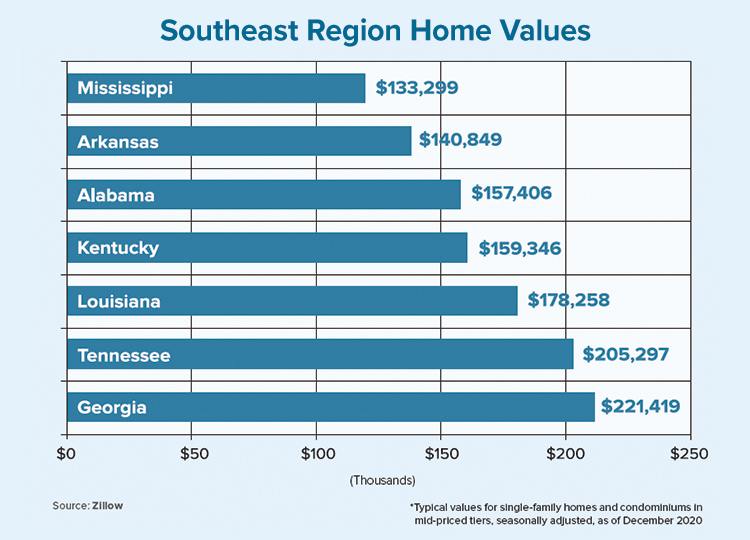College football in the South is part ritual, part religion, part big business. The 10 original members of the Southeastern Conference (SEC) have been playing each other annually since 1933, with the SEC expanding in 1991 and 2012 to include four more schools.
The conference has claimed 26 national titles in football, including six for the University of Alabama under coach Nick Saban since 2009. The SEC recently signed a 10-year TV contract with ESPN and ABC. The deal is valued at $300 million annually and goes into effect in 2024.
 Pigskin aside, the Southeast Region — which includes Alabama, Arkansas, Georgia, Kentucky, Louisiana, Mississippi and Tennessee — greatly values its institutions of higher learning. Established in 1785, the University of Georgia at Athens is the nation’s oldest state-chartered public university. Vanderbilt University in Nashville, led by its business, engineering, law and nursing programs, is frequently lauded in rankings from U.S. News & World Report. Tulane University in New Orleans (not part of the SEC) has received similar accolades and is the nation’s first major research institution to implement a public-service requirement for graduation.
Pigskin aside, the Southeast Region — which includes Alabama, Arkansas, Georgia, Kentucky, Louisiana, Mississippi and Tennessee — greatly values its institutions of higher learning. Established in 1785, the University of Georgia at Athens is the nation’s oldest state-chartered public university. Vanderbilt University in Nashville, led by its business, engineering, law and nursing programs, is frequently lauded in rankings from U.S. News & World Report. Tulane University in New Orleans (not part of the SEC) has received similar accolades and is the nation’s first major research institution to implement a public-service requirement for graduation.
Tennessee has three distinct regions that include the Appalachian Mountains in the east, rolling hills and the allure of Nashville in the central portion, and the rich farmland of the Mississippi River basin in the west. The Volunteer State’s per capita tax rate and cost of living are the second-lowest among all states. The share of Tennesseans employed in the manufacturing sector (which includes major companies such as Clayton Homes, Bridgestone and Nissan) is 38% higher than the U.S. average.
Mississippi’s gross domestic product was expected to decline by 4.3% in 2020, although personal income was forecast to grow by 8.3% due to federal relief tied to the COVID-19 pandemic. Among its 2021 legislative priorities, the Mississippi Economic Council is looking to attract and retain job talent through incentives, boost career readiness for high school students and secure an additional $200 million per year for transportation needs.
As of this past October, Kentucky had recovered two-thirds of the jobs lost near the start of the pandemic but had shed more than 107,000 positions since January 2020. Along with manufacturing and agriculture, the Bluegrass State relies heavily on logistics and distribution due to its centralized location. Some 540 logistics companies employ 75,000 people statewide, with about $4.7 billion invested in the sector since 2014.
The Atlanta metro area remains one of the fastest-growing areas in the country, adding 718,000 residents from 2010 to 2019. The ongoing BeltLine project, a former railway corridor being turned into trails and parks with streetcars, will eventually stretch 22 miles and connect 45 neighborhoods, and it has attracted some $6 billion in private construction investment, the Atlanta Business Chronicle reported. ●
 Typical home values in the Southeast Region as of December 2020 ranged from about $133,000 in Mississippi to about $221,000 in Georgia, according to Zillow. Three states (Tennessee, Georgia and Alabama) experienced year-over-year price growth of at least 8.3%, roughly in line with the national average at that time.
Typical home values in the Southeast Region as of December 2020 ranged from about $133,000 in Mississippi to about $221,000 in Georgia, according to Zillow. Three states (Tennessee, Georgia and Alabama) experienced year-over-year price growth of at least 8.3%, roughly in line with the national average at that time.
The Georgia Multiple Listing Service reported that nearly 11,000 homes were sold statewide this past December, up 13.6% year over year, while the $3.5 billion in sales volume that month represented an annual increase of 28.5%. In Alabama, 2020 home sales jumped 12.8% annually to more than 72,500. This figure was nearly 27% higher than the state’s five-year average, the Alabama Center for Real Estate reported.
Louisiana and Mississippi ranked first and second, respectively, among all states for the largest shares of mortgages at least 30 days past due as of October 2020. In the wake of Hurricane Laura this past August, the delinquency rate in Lake Charles, Louisiana, skyrocketed by 11 percentage points compared to October 2019, CoreLogic reported.
Focus: Agriculture
None of the Southeast Region states ranked in the top 10 nationally for agricultural cash receipts (sales revenues, government subsidies and insurance payouts) as of 2019, according to the U.S. Department of Agriculture (USDA). Arkansas ranked No. 14 at nearly $8.6 billion, followed by Georgia (16th, $8.4 billion) and Kentucky (24th, $5.5 billion).
Still, some ag products remain important food and economic staples for this region. Georgia produced nearly half of all peanuts in the country in 2019 and Alabama was third at about 10%. Arkansas leads the U.S. in rice production, with the grain accounting for 25,000 jobs and about $1 billion annually for the state’s economy.
Cotton also continues to be a key crop across the region. In 2019, USDA figures show that Georgia, Mississippi, Arkansas and Alabama each produced more than 1 million bales of cotton. Combined, the seven Southeast states accounted for about 44% of the nation’s cotton’s crop.
What the locals say
“The majority of the growth in north Alabama has been [due to] the development of the Redstone Arsenal. It’s not a military base but a government contracting site — a lot of defense contractors, the FBI, those types of government agencies. Facebook built a data warehouse. We’ve just had a ton of industry growth in government contracting and the fiber-optics space, so the movement to north Alabama is related to that. … A lot of retiring military personnel will seek defense-contracting jobs, and that’s where the Arsenal plays a huge role in our growth of VA (loan) business.”

Adam Hammond
Area manager, FirstBank Mortgage
3 Cities to Watch
Birmingham
 The youngest of Alabama’s major cities, Birmingham was founded in 1871 and later become known as the “Pittsburgh of the South” due to its voluminous iron and steel production. Today, its economy relies more heavily on industries such as health care and banking. The population has shrunk significantly since its peak in 1960. Walker County was recently removed from the metro area, further reducing the regional population to about 1.1 million and threatening Birmingham’s status as one of the nation’s 50 largest metros.
The youngest of Alabama’s major cities, Birmingham was founded in 1871 and later become known as the “Pittsburgh of the South” due to its voluminous iron and steel production. Today, its economy relies more heavily on industries such as health care and banking. The population has shrunk significantly since its peak in 1960. Walker County was recently removed from the metro area, further reducing the regional population to about 1.1 million and threatening Birmingham’s status as one of the nation’s 50 largest metros.
Little Rock
 The Arkansas capital has about 745,000 metro-area residents, although growth has leveled off in recent years. About 72,000 local jobs are tied to government, while Little Rock Air Force Base, Arkansas Children’s Hospital and the University of Arkansas for Medical Sciences each employ more than 4,000. A recent report from real estate investment platform Roofstock stated that Little Rock’s housing market favors renters, but it also is one of the more affordable U.S. cities for homeownership, with a median sales price of $212,400.
The Arkansas capital has about 745,000 metro-area residents, although growth has leveled off in recent years. About 72,000 local jobs are tied to government, while Little Rock Air Force Base, Arkansas Children’s Hospital and the University of Arkansas for Medical Sciences each employ more than 4,000. A recent report from real estate investment platform Roofstock stated that Little Rock’s housing market favors renters, but it also is one of the more affordable U.S. cities for homeownership, with a median sales price of $212,400.
New Orleans
 Indigenous people called the delta near the mouth of the Mississippi River “the land of many tongues,” and the Big Easy today remains a highly diverse mix of culture, language, food and music. Area Realtors reported tight inventory and brisk purchase activity in 2020 as regional home prices and sales each rose by 7.1% compared to 2019. Louisiana State University forecast New Orleans to add nearly 36,000 jobs this year and next, leaving the region about 1,400 jobs shy of pre-pandemic levels.
Indigenous people called the delta near the mouth of the Mississippi River “the land of many tongues,” and the Big Easy today remains a highly diverse mix of culture, language, food and music. Area Realtors reported tight inventory and brisk purchase activity in 2020 as regional home prices and sales each rose by 7.1% compared to 2019. Louisiana State University forecast New Orleans to add nearly 36,000 jobs this year and next, leaving the region about 1,400 jobs shy of pre-pandemic levels.
Sources: Alabama Center for Real Estate; Birmingham Business Journal; CoreLogic; Encyclopedia of Alabama; Georgia Multiple Listing Service; Insider; Kentucky Cabinet for Economic Development; Little Rock Regional Chamber; Louisiana State University; Mississippi Economic Council; Mississippi Institutions of Higher Learning; National Peanut Board; NewOrleans.com; NOLA.com; Roofstock; Tennessee Department of Economic and Community Development; Tulane University; University of Kentucky Center for Business and Economic Research; USA Rice Federation; USA Today; U.S. Department of Agriculture; U.S. News & World Report; Vanderbilt University


